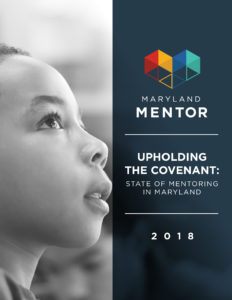What We’re Reading: Upholding the Covenant: State of Mentoring in Maryland
By Kelly Medinger
10-31-2018
A look at what’s happening in the world of mentoring across our state and how we all can help
 Earlier this year I introduced you all to my friend and colleague, Sadiq Ali, Director of Maryland MENTOR (for which I am a board member and the Knott Foundation is a funder).
Earlier this year I introduced you all to my friend and colleague, Sadiq Ali, Director of Maryland MENTOR (for which I am a board member and the Knott Foundation is a funder).
At that time, Sadiq was busy hosting “good old-fashioned town halls” with mentoring programs across Maryland – all the way from Allegany to Anne Arundel! Maryland MENTOR is in its first year of operation, so this process was instrumental in helping inform the organization’s future direction. Fifteen town halls, 200 attendees, and 100 pizzas later, the culmination of Sadiq’s listening tour is encapsulated in Upholding the Covenant: The State of Mentoring in Maryland 2018.
“Think of someone who you see as successful,” the report begins. “Chances are that person or the people who come to mind had a mentor.”
This statement gets to the heart of why mentoring programs exist: because no one can do it alone. We all need advice, emotional support, resources, social connections, and exposure to a world beyond our own to be the most successful people we can be. And when mentors provide that for our youth, great things happen.
I want to be clear, however, that this report isn’t a manifesto on the value of mentoring. Instead, it takes a deeper look at what mentoring organizations look like in our state, who they’re serving, their strengths, and the types of support they need. It also presents recommendations for how all stakeholders, Maryland MENTOR, public and private funders, mentoring organizations, education systems, and the corporate community can help.
In this way, Upholding the Covenant is one of the most comprehensive efforts to map the work of Maryland mentoring program providers and provide recommendations for better supporting them.
One of my favorite features of the report is how it paints a picture for each region of our state, so you can find out the challenges folks are facing in Baltimore City, the types of programs that exist in Northern Maryland, or the strengths of the work organizations are doing on the Eastern Shore. This not only customizes your data consumption to the area you’re working in, it also supports the idea that different communities have different landscapes.
Another great piece of information that I found useful was the delineation of mentoring models, such as one-to-one, group, hybrid, e-mentoring (who knew!), peer mentoring, and team. These models show how mentoring is so much more pervasive than what we might have imagined, in that mentoring relationships can develop in nearly any youth development context. “Mentoring is like water,” Sadiq said to me the other day, “it takes the shape of whatever vessel you pour it into.”
If you’ve had a mentor in your life, or if you’re mentoring someone now, I hope you’ll take a moment to pick up this report and learn more about what’s happening in the world of mentoring in Maryland and how we all can help support the mentoring community.
